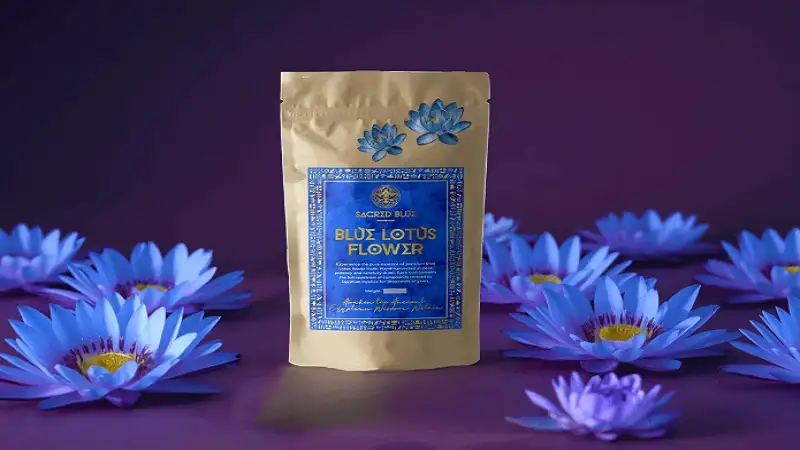The sacred blue lotus is a flower that has captivated the imagination of many cultures throughout history, revered for its spiritual significance, healing properties, and stunning beauty. Often associated with divine purity and enlightenment, this flower holds a special place in the traditions of ancient civilizations, particularly in Egypt and Asia. This article explores the history, symbolism, uses, and contemporary relevance of the sacred blue lotus, as well as its modern-day applications, including the use of ritual oils blue lotus.
What is the Sacred Blue Lotus?
The sacred blue lotus, scientifically known as Nymphaea caerulea, is an aquatic flowering plant native to Egypt and parts of Asia. It is often called the Egyptian blue water lily or blue lotus and is famous for its large, fragrant blue flowers that open in the morning and close at night. The plant thrives in shallow lakes and rivers, rooted in the mud but rising above the water’s surface to bloom with exquisite beauty.
Historical and Cultural Significance
Ancient Egypt: The Lotus of Life and Rebirth
In ancient Egyptian culture, the sacred blue lotus was much more than a flower—it was a powerful symbol of creation, rebirth, and spiritual enlightenment. Egyptians observed the flower’s behavior of opening at dawn and closing at dusk and linked it to the cycle of the sun and the concept of resurrection. The lotus flower was frequently depicted in Egyptian art, hieroglyphs, and mythology.
The god Nefertem, associated with healing and beauty, was often shown emerging from a blue lotus flower. Moreover, the flower represented the unification of Upper and Lower Egypt, signifying harmony and regeneration.
Symbolism in Other Cultures
Beyond Egypt, the blue lotus has played a role in Hindu and Buddhist symbolism, representing spiritual awakening and the purity of the mind. The flower’s connection to water and the sun embodies the harmony between the physical and spiritual worlds.
Physical Characteristics and Botanical Profile
The sacred blue lotus grows from thick rhizomes anchored in muddy bottoms, sending up long stems that support its flowers and leaves above water. The flower itself has multiple petals, usually a light blue or lavender-blue hue, with a bright yellow center. Its scent is sweet and mildly intoxicating, contributing to its use in rituals and ceremonies.
Uses of Sacred Blue Lotus
Spiritual and Ritual Use
The sacred blue lotus has been used in religious ceremonies and spiritual practices for millennia. It is believed to promote mental clarity, calmness, and a meditative state. Monks, priests, and shamans used the flower in various forms, including incense and ritual oils, to deepen their spiritual experience.
Medicinal Properties
Historically, the flower was utilized for its mild psychoactive and sedative effects. It was used to relieve pain, promote relaxation, and enhance mood. Today, it is sometimes consumed as a tea or extract, though scientific research on its medicinal properties remains limited.
Decorative and Aromatic Use
The alluring fragrance of the sacred blue lotus has made it a popular choice for perfumes and aromatherapy. The flower’s image adorns jewelry, art, and textiles, symbolizing purity and transcendence.
Ritual Oils Blue Lotus: Modern-Day Spiritual Practices
What Are Ritual Oils Blue Lotus?
Ritual oils blue lotus are essential or infused oils made from the petals or extracts of the sacred blue lotus flower. These oils capture the flower’s delicate aroma and its purported spiritual and healing properties. They are widely used in meditation, spiritual ceremonies, and personal rituals to invoke calm, enhance intuition, and connect with higher states of consciousness.
How Are Ritual Oils Blue Lotus Used?
- Anointing: Practitioners apply the oil to the forehead, wrists, or heart to promote spiritual awareness.
- Meditation: The oil is diffused or inhaled to deepen meditation and facilitate relaxation.
- Ceremonial Use: Used during rituals to cleanse and sanctify space, helping participants enter a sacred mindset.
- Massage: Incorporated in massage oils to relieve tension and enhance overall well-being.
Benefits of Ritual Oils Blue Lotus
- Mental Clarity: Helps clear the mind of distractions.
- Emotional Balance: Supports emotional healing and stability.
- Spiritual Connection: Aids in opening the third eye or enhancing intuitive insight.
- Relaxation: Provides a soothing effect on the nervous system.
How to Choose and Use Blue Lotus Products Safely
While the sacred blue lotus and its products like ritual oils are generally considered safe, it’s important to:
- Purchase from reputable sources to ensure purity and quality.
- Use in moderation to avoid potential side effects.
- Consult with a healthcare professional if pregnant, nursing, or on medication.
- Perform a patch test to check for allergic reactions when using oils topically.
Growing and Cultivating the Sacred Blue Lotus
For enthusiasts wishing to grow their own sacred blue lotus, it requires a warm climate and a water garden or pond. The plant needs:
- Shallow water (about 2-6 inches deep).
- Plenty of sunlight.
- Nutrient-rich soil.
- Stable warm temperatures (ideally 75°F to 86°F).
Cultivating the lotus can be a rewarding experience, connecting gardeners with nature and ancient tradition.
Conclusion: The Enduring Legacy of the Sacred Blue Lotus
The sacred blue lotus continues to inspire awe and reverence in modern times, carrying its ancient symbolism of purity, enlightenment, and spiritual awakening into contemporary spiritual practices. From its profound roots in Egyptian mythology to its use in modern-day ritual oils blue lotus, this flower bridges the gap between the past and present, the physical and spiritual.
Whether you encounter the blue lotus in art, ritual, or as a fragrant oil, its presence reminds us of the timeless journey toward inner peace and awakening. Embracing the sacred blue lotus allows us to honor an ancient tradition that celebrates the beauty of life, transformation, and spiritual harmony.
